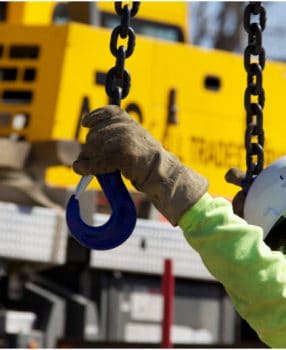 Contributed by Bob Kozickie, Technical Sales Support Manager
Contributed by Bob Kozickie, Technical Sales Support Manager
A ‘Competent Person’ and ‘Qualified Person’ are two references contained in various standards that have clearly defined responsibilities associated with their positions. The ability to perform a particular task is often based on the amount of education and training an individual has received. This is especially true when it concerns alloy chain slings and Below the Hook lifting devices. Industry Standards such as the Occupational Safety and Health Administration (OSHA) and the American Society of Mechanical Engineers (ASME) specifically define that an individual is required to be either competent or qualified with regards to the design, inspection, and repair of alloy chain slings and BTH lifting devices. We will explain the individual roles these two functions play to improve safety within the workplace or on a job site.
A good place to start is to look at the employers’ responsibilities, as defined by the Standards, with reference to the OSHA requirements. OSHA.gov is a free website accessible to everyone who is inquiring as to the legalities regarding workplace safety concerns. The OSHA Standard is a statutory document which means that the information it provides is a legal requirement. The first point of reference to be aware of is the General Duty Clause. This document, in particular, is the basis for all workplace safety. It states, “Each employer shall furnish to each of their employees employment and place of employment which are free from recognized hazards that are causing or likely to cause death or serious physical harm to their employees”. This statement establishes that the employer must provide employees with adequate training to minimize the risk of a potential harmful work environment. The employer must also staff positions with candidates that meet the qualifications of those particular positions. When it comes to competent versus qualified we need to understand the role each plays within and outside the organization.
A competent person is the individual responsible for identifying a potential safety hazard prior to any work being performed. The best way to understand their responsibilities is to identify what OSHA states they are required to do on a daily basis. OSHA states that a competent person, as designated by the employer, is the person responsible for performing the daily inspection of their alloy chain slings and BTH equipment before use. This potentially empowers the competent person to have the ability to shut an operation down. During the daily inspection, if the employee discovers criteria for removal on an alloy chain sling or BTH lifting device, they are then required to tag it and remove it from service. At that point, the quarantined equipment is then required to be reviewed further by a qualified person.
The inspection criteria with respect to alloy chain slings are contained within OSHA 1910.184 and ASME B30.9, B30.10, and B30.26. The BTH inspection criteria is defined in ASME B30.20. OSHA 1910.184 states, “Each day before being used, the sling and all fastenings and attachments shall be inspected for damage or defects by a competent person designated by the employer”. There is very little mentioned with regards to BTH devices within the OSHA Standard, therefore, we must then refer to the consensus document, ASME, for those requirements. The competent person definition and requirements contained in ASME B30.20 mirror those for alloy chain slings. The qualified person; however, has different definitions depending on whether it is an alloy chain sling or BTH device.
A qualified person, in general, is the individual or entity who can resolve a problem and provide solutions in order to prevent future problems. A qualified person is defined as, “a person, who by possession of a recognized degree in an applicable field and/or certificate of professional standing , or who, by extensive knowledge, training, and experience, has successfully demonstrated the ability to solve or resolve problems relating to the subject matter and work”. The qualified person, with regards to alloy chain slings, may be an engineer within the company or someone outside the company who has extensive knowledge of alloy chain slings and their applications.
The Qualified Person’s qualifications for design, modifications, and repair of BTH devices require additional expertise as defined in ASME B30.20. When designing new and assessing existing lifters, the qualified engineer must also have experience in the design of BTH lifting devices. A good analogy is that an engineer that designs steel bridges or buildings is not necessarily qualified to design BTH lifters and vice versa. The rationale behind this is that through the experience and knowledge of using a variety of different alloy materials and knowing exactly where to locate necessary safety features such as stress reliefs, the BTH engineer knows how to design the device for both strength and safety. They are required to follow the guidelines contained within ASME B30.20-BTH-1, Design of Below the Hook Lifting Devices, when performing their function.
Whether in a workplace or on a job site, knowing who the Competent Persons and Qualified Persons are would be quite beneficial when it comes to safety. Having the employers’ designation as Competent Person or Qualified Person demonstrates their compliance with respect for the OSHA and ASME Standards. The persons that are deemed as competent and qualified within an organization or as an outside resource have extremely important responsibilities. Their eyes and aptitude are on safety’s front lines to assure all workers end their day going home to their family and friends.